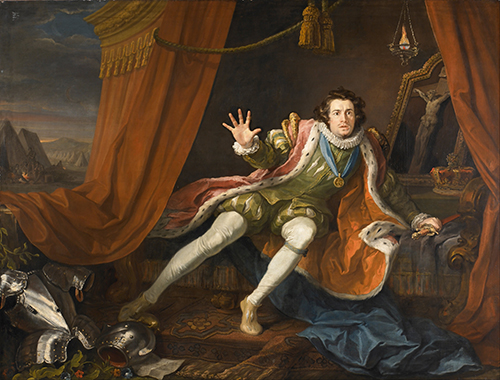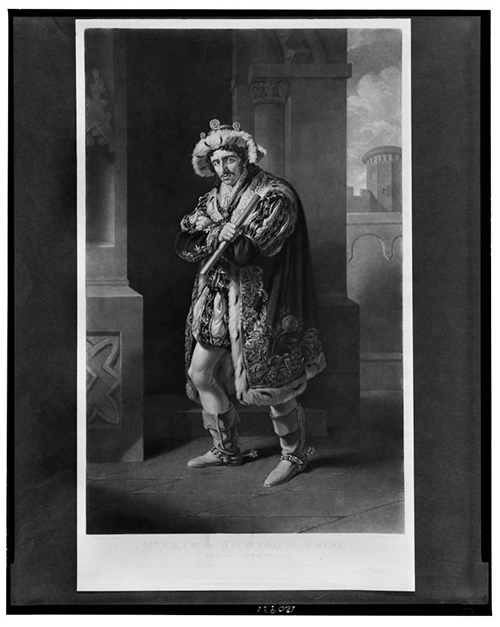Richard III
Richard III
By William Shakespeare
October 11 - 19, 2019
Timms Centre for the Arts
All performances start at 7:30 p.m.
Preview October 10
No Show October 13
Matinee October 17 at 12:30 p.m.
Shakespeare's most notorious play is reimagined for our fractious times. In a world much like our own, a fragile society falls to a ruthless demagogue. This visceral, ensemble production examines how dictators manipulate our fears to acquire and retain power.
Poster imagery by Kelsi Kalmer
- 1. Cast
Richard Caitlin Kelly
Buckingham/Chorus Braden Butler
Stanley/King Edward/Chorus Jackson Card
Elizabeth/Chorus Beverley Rockwell
Duchess York/ Cardinal/ Chorus Chantal Perron*
Margaret/ Edward Junior/Chorus Nikki Hulowski*
Hastings/Richmond/Chorus Sheldon Stockdale
Lady Anne/ York Junior/Tyrrel/Chorus Emily Anne Corcoran
Rivers/Catesby/Dorset/Chorus Hayley Moorhouse*The participation of this Artist is arranged by permission of Canadian Actors' Equity Association under the provision of the Dance-Opera-Theatre Policy. - 2. Creative Team
Director Max Rubin**
Set and Lighting Designer Jeremy Gordaneer
Costume Designer Feng Yi Jiang
Sound Designer Aaron Macri
Vocal Coach David Ley
Movement Coach Marie Nychka
Stage Management
Stage Manager Stacy Vanden Dool
Assistant Stage Managers Frances Bundy
Hanna Loh
Faculty Advisors
Directing Advisors David Kennedy
Jan Selman
Design Advisor Lee Livingstone
Stage Management Advisor John Raymond**In partial fulfilment of their MFA Directing Thesis Project.
- 3. Production Team
Production Manager Gerry van Hezewyk
Technical Director Larry Clark
Wardrobe Manager Joanna Johnston
Cutter Julie Davie
Wardrobe Assistant Amelia Vadnais
Master Carpenter Darrell Cooksey
Scenic Carpenters Barbara Hagensen
Jacob Fulton
Lead Scenic Artist Madi Blondal
Scenic Artists Michaela Bonato
Lieke den Bakker
Casey Irwin
Thomas Johnston
Derek Miiller
Shella Novakovic-Apostol
Andraya Rodrigues
Beka Taylor
Properties Master Jane Kline
Properties Assistant Tiffany Martineau
Lighting/Video Supervisor Jeff Osterlin
Head of Lighting Drew Lekic
Lighting Technicians Kai Yakichuk
Emma Nokes
Derek Miiller
Dylan MacKay
Jack Thompson
Thomas Johnston
Shella Novakovic-Apostol
Sound Supervisor Matthew Skopyk
Sound Assistant Micaila Herbold
Running Crew
Lighting Operator Sherry Alvaro
Patton Wei
Sound Operator Micaila Herbold
Stage Crew Jacob Fulton
- 4. Dramaturgical Notes
DRAMATURGICAL NOTES
By Stefano Muneroni and Amanda Goldberg
The Politics of Shakespeare's Richard III Then and NowWilliam Shakespeare wrote Richard III when he was in his late twenties, and he entrusted his iconic protagonist to Richard Burbage, the undisputed star of the Elizabethan stage. Despite being one of the first plays written by the author, Richard III enjoyed immediate success and was instrumental in establishing Shakespeare as one of the most profitable playwrights in London.
Drawing on the well-known Wars of the Roses, the bloody conflict between the houses of York and Lancaster, the play aspired to celebrate the birth of the Tudor dynasty. It was a most natural and rewarding choice for Shakespeare, considering that Henry VII, who succeeded Richard III to the throne of England in 1485, was the first Tudor king and none other than Queen Elizabeth I's grandfather. Richard is for Shakespeare the perfect means to celebrate Queen Elizabeth's nation-building efforts and to praise the Tudor monarchy by vilifying its opponents. The battle of Bosworth Field, that marked the end of the civil war, is for Shakespeare the end of political terror and the beginning of a new era.
His admiration for the Tudors, together with his unrivaled use of language and marvelous imagination, model Richard as a wonderfully villainous character that might have been quite different from the historical person. In fact, Richard III shaped the portrayal of the king and his short-lived reign for centuries to come - more vividly, if less accurately, than Edward Hall's and Raphael Holinshed's chronicles.
Richard III follows chronologically Henry VI, Part Three, where Richard kills the ruling monarch and claims famously to have "neither pity, love, nor fear." His line "I am myself, alone" resonates with the moral and psychological complexities that make this character so captivating and unforgettable. Both in Henry VI and Richard III, Richard is a quintessential villain, rivaling in wickedness and corruption Iago in Othello and Angelo in Measure for Measure. Yet he is a fascinating antihero who dares the audience to like him for his political cunning and smarts; at times even humorous in how he rejoices in the unexpected success of his own manipulations.
If the celebration of the Tudors prompted Shakespeare to compose Richard III during the Renaissance, what is it that urges today's directors to stage it and audiences to see it? What is it about this play that continues to sustain a seemingly constant stream of theatrical productions and cinematic adaptations? We must ask and answer these questions in order to probe how Richard III might reflect current concerns and articulate a meaningful engagement with the world at large.
'Now,' the first word of the play and the first uttered by Richard himself, situates the action in the present - the protagonist's present as well as our own, as we experience his story in Edmonton in 2019. Richard III reaches back into history to explore the present time and to probe what it means to be human in the here and now. If a play does not do these things, it can never truly connect with an audience.
One can look at Richard III as a training ground for developing theatre artists, as a representative text of the western dramatic canon, or as a way to bridge dramatic literature with the live performance of the play, but the cultural longevity of Shakespeare's text lies in its core statement about the dangers of unbridled power and the devastating outcomes of authoritarianism. This was as true in the sixteenth century as it is in our day and age. Forms of government change with the passing time, but the risk of losing one's own freedom to tyranny is ever present.
Richard III is a case study of what might happen when a deceitful strongman with unbound political aspirations is met by feeble opposition. It is indeed a play for our time as we are confronted with the global rise of fascistic ideologies. It reminds us that authoritarianism is as much the result of an erosion of democratic values as it is the outcome of people's indifference and passivity. Richard's rise to power is undoubtedly due to his Machiavellian calculations, but he would never have become king had the people around him paid attention and reacted sooner to stop him.
Today, the resurgence of authoritarianism is often met by inadequate resistance. Many feel disbelief and a demoralizing exhaustion in the face of politicians' lies and distortion of factual evidence. As large swaths of the electorate feel disempowered and less prone to react against injustice and abuse, a corrupt political class, often emboldened by an astute autocrat, gains more power breeding crime and abuse into an already corrupt system.
The reign of Richard lasted only twenty-six months, but it managed to change England's historical path forever, ending in a trail of destruction and death. Perhaps the most compelling argument that contemporary audiences can relate to in Shakespeare's play is the importance to treasure and respect the democratic process, to question power and those who wield it, and to be cautious of politicians who put personal gain above the health of the republic.
Representation of King Richard III through the agesThe depth and brilliance of Richard as a character has been captivating actors' imagination for ages. Playing the role has launched or defined many careers, often leading to true stardom status. In 1699, a theatre manager named Colley Cibber wrote and performed an edited version of Shakespeare's Richard III. The text he cut from the original mostly affected supporting characters almost eliminating the role of Margaret. These alterations proved to make the role of Richard an intrinsically dominant figure. However, this version did not garner a great response. It wasn't until 1741 that Cibber's version of Richard III received positive recognition due actor superstar, David Garrick.

David Garrick as Richard III painted by William Hogarth in 1745
Garrick's interpretation of the role was remembered as highly expressive but equally naturalistic. His quick success secured him a job as the lead performer at Drury Lane, a theatre that he began to manage in 1747 with immense success. He would continue to produce many more plays by Shakespeare, restoring much of the original text. While the condensed adaptations of Richard III remained popular during the eighteenth century and most of the nineteenth century, later critics and artists rejected modifications of the original text. Richard III catapulted Garrick's career along with immortalizing his contribution to the world of theatre. Correspondingly, Garrick's performance of Richard confirmed the complexity of the role, as well as established this character as a dream role that all actors would aspire to play.Shakespeare's original play, as well as the title role, has proven to propel many actors to fame. During the early 19th century, a prominent English actor known for his controversial and drunk behavior, Edmund Kean, took on the role of Richard after his Drury Lane debut as Shylock in The Merchant of Venice. Kean quickly became recognized for tackling Shakespearean villains. In similar terms, American actor, Edwin Forrest, owed his start to Richard's words. The story goes that after trying to find employment in 1820, Forrest participated in an experiment on the effects of nitrous oxide. While high, he recited one of Richard's soliloquies from Richard III. This fluke led Forrest to his formal stage debut a few months later at the Walnut Street Theatre in Philadelphia.

Mr. Kean in Richard the Third Act IV Scene 4 painted by J.J. Halls
The character of Richard made his first appearance to the modern world at the beginning of the twentieth century. Leopold Jessner, a director known for his work in German expressionist theatre, was among the first group of directors to use Richard III as a platform to shed light on the rise of fascism after WW1. In 1942, during the horrors of Nazi Germany, Donald Wolfit played a recognizable Richard. Many critics have noted the direct parallels between Hitler and Wolfit's Richard. Through a time of political violence, the play acted as a mirror. Tragically, European audiences understood this story far too well. During one performance in 1942, the audience were shaken as they had to run for shelter because of an active bomb alert.In 1955, Sir Laurence Olivier acted, produced, and directed a film adaptation of Shakespeare's Richard III. While Olivier was not the first Richard to appear on screen, he certainly was the most memorable. For his performance, Olivier received a nomination for the Academy Award for Best Actor and won the BAFTA Award for Best British Actor. Since this film, there have been at least a dozen other Hollywood versions, some of the most famous portrayals include Sir Ian McKellen in the 1955 film adaptation set in a fictional 1930s fascist England, and Al Pacino in the 1996 documentary film Looking for Richard. This film was Al Pacino's directing debut. It explored an insightful examination of the character and his continued significance through history and modern culture.
Richard III continues to be performed on average every two years in Canada, UK and USA. In 2003, Barry Kyle directed an all-female production of Richard III at Shakespeare's Globe with Kathryn Hunter playing the title role. In 2017, Romanian theatre director, Silviu Purcarete staged a production in Tokyo with an all-Japanese cast for the first time.
Works CitedArcher, Corinna. "Production History of Richard III." Production History of Richard III, 1 Jan. 1970, Web. Accessed 2019. http://richardiiicasebook.blogspot.com/2010/02/production-history-of-richard-iii.html.
Tanaka, Nobuko. "It's More than 400 Years Old, but 'Richard III' Is Just as Relevant Today." The Japan Times, Web. Accessed 2019. https://www.japantimes.co.jp/culture/2017/10/12/stage/400-years-old-richard-iii-just-relevant-today/#.XX76pS2ZMQ8.
Walkling, Saffron Vickers. "Step by Step Richard III: from Jessner to Jonjo." Shakespeare Travels, 3 Nov. 2012, https://saffronatstudy.wordpress.com/2012/11/03/step-by-step-richard-iii-from-jessner-to-jonjo/.
"Reforms of Drury Lane Theatre." Encyclopedia Britannica, Web. Accessed 2019. https://www.britannica.com/biography/David-Garrick/Reforms-of-Drury-Lane-Theatre.
"Stage History: Richard III." Royal Shakespeare Company, Web. Accessed 2019. https://www.rsc.org.uk/richard-iii/about-the-play/stage-history.
